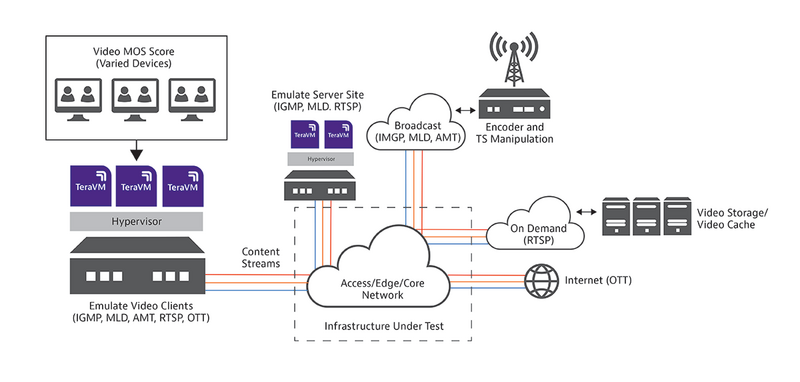Video Delivery
Emulating the Leading Video Delivery Protocols

The success of a Next Generation Video Service is dependent on the reachability and reliability of the video being delivered to the viewer’s screen. Next generation video services throw up any number of unique challenges, each dependent on the function in the network e.g. at the content headend the provider needs to ensure that all the video streams are available and accessible or for the network provider the challenge is to manage the continued growth in video bandwidth demands.
However, the key goal for any next generation video service is to ensure that the video can be reliably delivered with zero quality issues to a core number of video display types for each and every user. Unlike data, users will not accept a poor video viewing experience.
Emulating the Leading Video Delivery Protocols
TeraVM is consistently used to test video streaming services as it provides performance measurements from the perspective of the end viewer (video quality - MOS) and is also used to test the network infrastructure for performance limitations as it supports all the major network video delivery protocols: broadcast (IGMP/MLD/Automated Multicast - AMT), on demand (RTSP) and/or over the top (HTTP adaptive streaming). In addition, a unique capability of TeraVM is the ability to use PCAP file replay (>1GB) to test with new or undefined video flow types.
As an integrated test and performance measurement solution, TeraVM provides a unique set of video performance measurements specific to each video protocol type. In addition, TeraVM enables subjective quality scoring (Mean Opinion Scores – MOS) on each and every one of the received video streams.
Targeted Device Testing
VIAVI is used extensively in testing performance and accuracy of video broadcast headends, content cache servers, video on demand servers, adaptive stream content servers and video billing services.
Video & Audio Performance Analysis
Video entertainment is more than just a visual experience, it’s a visual and audio experience. Testing video in isolation does not reflect a true user’s experience, misaligned audio frames can equally generate a negative experience.
TeraVM offers both video and audio performance based metrics centered on the industry’s standard performance measurement - Mean Opinion Scores (MOS). A key differentiator of TeraVM is the ability to run tests with real-time analysis enabling performance testing of live broadcasts. Equally, TeraVM's per flow architecture results in quality scoring for each and every media stream being received.
Why Use per flow Testing For Video Content?
The simplest explanation is to take the example of a modern home, its clear there are two real video consumption scenarios:
- Residential users are streaming content from different sources e.g. Netflix, Youtube, etc
- Video is consumed on a number of device types i.e. smart phones, tablet PCs, set-top boxes, etc
It's evident that video consumption has moved on from the traditional group of people in front of a single display e.g a family in front of the TV, and video is now being consumed on a more personal basis. Through per flow emulation its now possible to test video consumption in the exact same way.
Service Providers are using TeraVM per flow architecture to represent these real world usage scenarios to determine the performance impact that over the top content has on regular services such as voice. Similarly network equipment manufacturers are using TeraVM's per flow architecture to determine the scalability of their networking devices and the ability to manage a large volume of unique video stream requests generated by unique individual users.